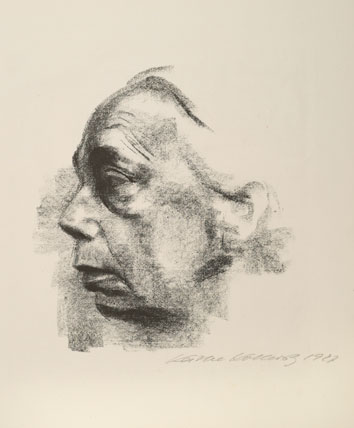
Käthe Kollwitz (German, 1867–1945). The Mothers (Die Mütter), 1922–23. Woodcut on heavy Japan paper, 1813⁄16 x 259⁄16 in. (47.8 × 64.9 cm). Brooklyn Museum, Carll H. de Silver Fund, 44.201.6. © 2012 Artists Rights Society (ARS), New York/VG Bild-Kunst, Bonn

Käthe Kollwitz (German, 1867–1945). The Mothers (Die Mütter), 1922–23. Woodcut on heavy Japan paper, 1813⁄16 x 259⁄16 in. (47.8 × 64.9 cm). Brooklyn Museum, Carll H. de Silver Fund, 44.201.6. © 2012 Artists Rights Society (ARS), New York/VG Bild-Kunst, Bonn

Käthe Kollwitz (German, 1867–1945). Self Portrait (Selbstbildnis), 1927. Lithograph on thin China paper, 247⁄8 x 1715⁄16 in. (63.2 × 45.6 cm). Brooklyn Museum, Museum Collection Fund, 39.15. © 2012 Artists Rights Society (ARS), New York/VG Bild-Kunst, Bonn

Käthe Kollwitz (German, 1867–1945). The Widow I (Die Witwe I), 1922–23. Woodcut on heavy Japan paper, 26 × 1811⁄16 in. (66 × 47.5 cm). Brooklyn Museum, Carll H. de Silver Fund, 44.201.4. © 2012 Artists Rights Society (ARS), New York/VG Bild-Kunst, Bonn

Käthe Kollwitz: Prints from the “War” and “Death” Portfolios
March 15–November 10, 2013
This selection of thirteen rarely displayed prints by German Expressionist artist Käthe Kollwitz, from the Brooklyn Museum’s collection, focuses on works relating to the impact of war. The exhibition features the artist’s most famous print cycles, War (Krieg) and Death (Tod), created between World War I, when her son was killed in Flanders, and World War II. The Death cycle of lithographs includes Woman Entrusts Herself to Death and Death Seizes the Children. These images of familial tenderness, highlighting the daily struggles of the poor and working classes, and the degree to which they bear the burden of war, are the primary focus of Kollwitz’s canon. Also on display is a 1927 self-portrait of Kollwitz in profile.
Born in Königsberg, East Prussia, Kollwitz began producing etchings in the late nineteenth century, first working in a naturalistic style and later moving toward Expressionism. A lifelong socialist and an outspoken pacifist after World War I, Kollwitz was expelled from the Prussian Academy of Arts when Hitler came to power, and was later barred from exhibiting.
Käthe Kollwitz: Prints from the “War” and “Death” Portfolios is the latest exhibition in the Herstory Gallery of the Elizabeth A. Sackler Center for Feminist Art, which is devoted to subjects that explore the significant contributions of the women named in The Dinner Party by Judy Chicago.
Käthe Kollwitz: Prints from the “War” and “Death” Portfolios is organized by Catherine Morris, Curator of the Elizabeth A. Sackler Center for Feminist Art, Brooklyn Museum.
This exhibition is made possible by the Elizabeth A. Sackler Foundation.